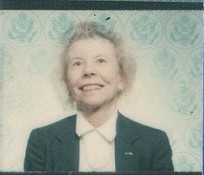
Eloise Page was a Southern lady through and through. Born in Richmond, a descendant of Virginia gentility, Eloise always spoke warmly of her Southern upbringing and the charms of the South. Having never married, she insisted that she be called Miss Page, instead of Ms. Page and spoke in a quiet drawl. Petite in frame, Eloise rarely wore slacks, preferring instead modest dresses. She never stepped out in public without her hair perfectly coifed, her finger nails painted and white gloves for special occasions.
Having studied piano from an early age, Miss Page majored in music while attending Hollins College in Roanoke, leading her mother to believe that she would pursue a career in the arts. Eloise was also highly involved with the Christ Episcopal Church in Georgetown where she taught Sunday school, served on the vestry and directed the altar guild and the flower committee.
Miss Page was highly respected in her community and was renowned for treating her beloved golden retrievers like they were her children. Miss Page was also a spy for the CIA. At her retirement in 1987, she was the highest-ranking female officer and one of the CIA’s leading experts on terrorist organizations.
Eloise got her first taste of the espionage world in 1942 when she took a job as the secretary to General William J. Donovan. Donovan, who earned renown for his leadership during WWI, was the director of the Office of Strategic Services (OSS) and was tasked with the job of turning America’s intelligence gathering into a professional organization. In working closely with Donovan, Eloise quickly picked up the lingo, main players and learned to love the fast paced, decisive nature of espionage.
Toward the end of the war she was transferred to a division within the OSS, called X-2. X-2 was tasked with gathering counterintelligence and with this division Eloise found herself stationed in Belgium, where she helped establish the first post-war station in 1945. Shortly thereafter the OSS was disbanded.
However, President Truman quickly recognized that there was still a need for intelligence gathering in the post-war world, so in 1947 he created the CIA. Eloise Page was one of their first employees. Only this time she wasn’t a secretary. Page worked in the Directorate of Operations (DO), which is now known as the National Clandestine Service. Through persistence and hard work, Page moved up through the ranks at the CIA, but her love was the work not the promotions. She was known as someone who could get things done and had an uncanny ability to navigate interagency warfare through sheer force of will.
She was known by colleagues as the “iron butterfly” and a “Southern lady with a core of steel.”
Page worked her way up to be the directorates #3 officer and eventually a case officer. From there she was named the Chief of Station (COS), the highest rank that an operative can hold while stationed abroad, in Athens, Greece, in 1978. She was the first woman to be promoted to the position of COS. In the years leading up to her assignment in Greece, Page had turned down two other COS promotions in other countries because there was little to no counter-intelligence work to be done. The positions were largely ceremonial. Page wanted a challenge and she found one in Greece. The former COS, Richard Welch, had been assassinated by Marxist terrorist three years earlier. Greece was volatile, and Page excelled in her position.
An advocate of utilizing technology in intelligence operations, Page was tapped to head up a new technology division called the Scientific Operations Branch. Page declined, stating, “I’ll be damned if I’ll be the chief SOB.” So the division was renamed, and she took the position.
Page was the first woman to serve as the Deputy Director of the Intelligence Community staff and the Chairman of the Critical Collection Problems Committee. She became such a well-known authority on terrorism that upon her retirement from the CIA in 1987 she was asked to join the faculty of the Defense Intelligence College. She also taught counter-terrorism to young analysts and operatives at the Defense Information Systems Agency at Bolling Air Force Base in Washington D.C.
In 1997, when the CIA turned 50, then director George J. Tenet awarded Trailblazer awards to 50 officers who helped shape the agency and lead it in new directions. Eloise Page was awarded one of those 50 awards, which included an honorary lifetime badge for entrance into CIA headquarters in Langley, Virginia.
On October 16, 2002 Eloise Page died from a heart attack at the age of 82. CIA Director Tenet issued the following statement “From her earliest days of service with OSS, she was a source of inspiration to others. She will be forever.”
